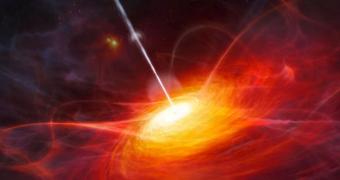A group of astronomers recently observed the ignition of a new quasar in the distant Universe. The event was brought on by a massive collision between two galaxies. The merger was observed using two, renowned NASA telescopes.
In a paper published in the latest issue of the esteemed Astrophysical Journal, researchers from the Leibniz Institute for Astrophysics, in Potsdam, Germany, explain how they used the NASA/ESA Hubble Space Telescope and the NASA Spitzer Space Telescope to study the energetic event.
A quasar (quasi-stellar radio source) is an active supermassive black hole that lies at the core of a distant galaxy. In many cases, galactic mergers also result in their respective black holes uniting, and forming truly huge dark behemoths.
Quasars are easily among the brightest and energetic regions in the Universe. They can be observed from very far away, and provide astronomers with the capability to confirm measurements of cosmic distances that are based on white dwarfs and supernova remnants.
“For the first time in a large sample, we are catching galactic systems when feedback between the galaxy and the quasar is still in action,” LIA postdoctoral researcher Tanya Urrutia explains.
“Quasars profoundly influence galaxy evolution and they shape the properties of the massive galaxies we see today,” adds the investigator, who was also the lead author of the Astrophysical Journal paper.
Interestingly, for all their brightness and radiation emissions, quasars are in fact rather small, as their diameters rarely exceed a few light-years. In comparison to galaxies, they are rather insignificant, since they rarely exceed the diameter of the solar system.
“An amazing aspect of this work is that something that is happening on a very small scale can affect the host galaxy so much. To put it in context, it is a bit like if somebody playing around with a stick at the beach could affect the behavior of all the oceans in the world,” Urrutia goes on to say.
For this study, the team analyzed a sample of 13 quasars, all of which are located around 6 billion light-years away from Earth. This means that we can now see them as they appeared when the Universe was only half of its current age.
“The evolution of quasars is intimately linked with the evolution of galaxies and the formation of their stars,” Urrutia concludes.

 14 DAY TRIAL //
14 DAY TRIAL //